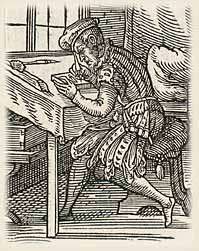
Gutenberg's Epoch-Making Achievement
Page 1 of 2
The invention of letterpress printing facilitated the copying of texts and also reduced the costs involved. This, in turn, gave certain classes of the population who until that time had been excluded from the education process access to learning. Moreover, the possibilities of using this medium for propaganda were quickly recognized by contemporaries. Without letterpress printing, the Reformation would not have spread as rapidly in Europe as it did.
 |
|
Engraver - Woodcut of J. Amman
1568 (detail)
|
Naturally Gutenberg's invention - the reason for his being named "Man of the Millenium" - did not just suddenly spring up from nowhere, without any reference to available technical developments. His ideas were based on known processes, for example the printing of block books by means of wooden tables into which the text with illustrations had been engraved. Moreover it can be assumed that Gutenberg was familiar with stamp printing which was used to inscribe bindings on manuscripts. The seal-engraver practiced the art of engraving which was used to manufacture stamps and seals. Various casting techniques were also known and employed in casting bells and dying coins.